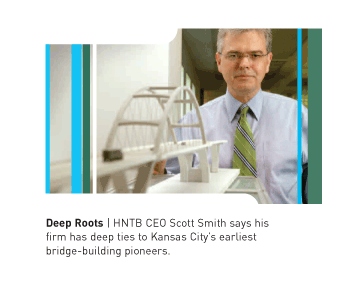“We really do a number of groundbreaking and challenging structures,” Scarangello said, “like the world’s tallest
buildings, long-span bridges, those types of projects. The driver for opening our KC office is the very talented pool of engineers and I think one reason is the base of sports architects. They’re used to working on some of the most challenging projects in the world. That gives you a base of talent that is used to working on very large-scale buildings and long spans. You won’t find that in LA or Denver, but in Kansas City you find people who are used to that.”
Many of the area’s engineers are Midwesterners, often coming from small rural or farm-based communities. That translates into a philosophy and work ethic that are valued by engineering firms.
“I think there’s a work ethic here in Kansas City and the Midwest that’s very important to getting done the things we do,” noted Kim Mastalio, president of the Strategic Sales and Marketing Division for Black & Veatch. “I know our people work hard, work long hours. It’s part of what they do and what who they are.”
Many in this group travel frequently and say Kansas City workers are among the best they see anywhere. “There’s just not a more productive workforce anywhere in the United States,” Graves argued. “The Midwest work ethic that I have seen is a real factor for this and other professions.”
Mastalio also stressed the tie of local engineers to rural mid-America. “I think the growth of engineering here was very much a part of rural American moving to the cities. Engineering has always tended to attract people from rural America. They’re raised in an environment where building things and solving problems is part of the fabric, and that’s really what
engineering is about.”
Joe Marsh, Lenexa division manager for Terracon Consultants, said an important intangible is attitude. Although difficult
to document, he believes that the friendly, easy-going nature of Midwesterners makes them perfect for national and international engineering, which is based above all on trust and relationships.
“The people in this area have a positive outlook on life and basic trust,” Marsh said. “That’s a critical aspect of engineering.”

NEW CHALLENGES
The region’s century-old position as a
world leader shows no sign of crumbling. A huge backlog of public works needs facing this country and skyrocketing demand for new construction in emerging nations are among several reasons that demand for engineers is on the upswing.
“The nation’s decaying infrastructure—
that’s the foundation for our future growth,” said Don Curtis, Kansas City manager for HDR engineering. “You’ve got to take care of it.” Beside the basic demand for new bridges and other replacement or update structures, tighter standards for areas such as wastewater treatment also increase demand by requiring new or upgraded facilities.
“This country is not catching up with its infrastructure needs,” Graves agreed. “Our water and wastewater, roads and highways all need work. This gets press in Kansas City, but it doesn’t get much attention nationally where it’s equally true.”
Kansas City alone faces millions of dollars in work to modernize a storm water system that mixes rainwater and sewage in places like Brush Creek. Nationally, the demands range from thousands of small projects such as rural roads, to major issues illustrated by levees in New Orleans levees and an interstate bridge in Minneapolis.
HDR is working on Kansas City’s water and wastewater problem, as well as design of the Gardner intermodal facility, good examples of the old and new facing engineers today. Other projects under way by local firms include the Paseo Bridge replacement and Kauffman Stadium upgrades. Every big city of any age, anywhere in the world has similar to-do lists.
“We’re seeing a lot of transportation projects—highways and bridges, airports, railroads and mass transportation projects,” said HNTB’s Smith. “There’s a lot of work out there.” Even in this economic climate. HNTB engineering division alone has 15 projects with price tags of $5 million or more.
“We are seeing more thought on innovative financial options,” Smith said, noting that fuel taxes are falling and expected to fall more. “You’ll probably see more discussion of toll roads, user fees and other revenue sources. There is resistance to that, but as more people see how they (encourage) good maintenance it becomes a non-issue.”
Marsh said the variety of engineering projects is also likely to insulate the profession from economic woes. His firm is involved in myriad project, including the Paseo Bridge, nuclear power plants and wind farms. Others are engaged in Brownfield redevelopment projects in both large and small communities, while telecommunications projects continue to expand—including small but creative projects such as transmission towers designed to blend by looking like large evergreen trees.
THE SHRINKING PLANET
Globalization is probably the biggest trend in terms of demand, often impacting the U.S. in surprising ways. Economic
development professionals talk a lot about international trade, and it’s significant in the list of factors impacting engineering projects.
Locally, that impact is visible in intermodal projects under construction at the former Richards-Gebaur Air Force Base and near Gardner, Kan.—with local engineers leading the way. Those projects are
.